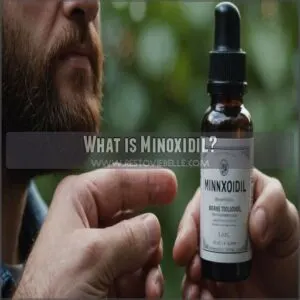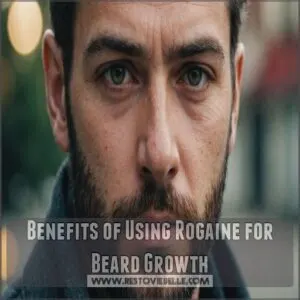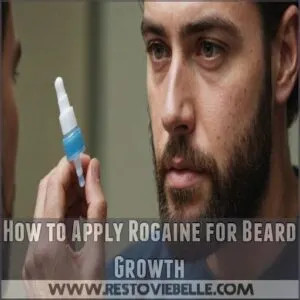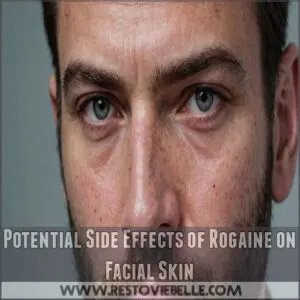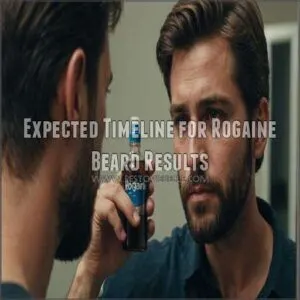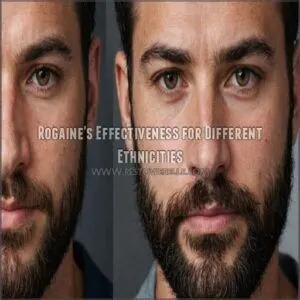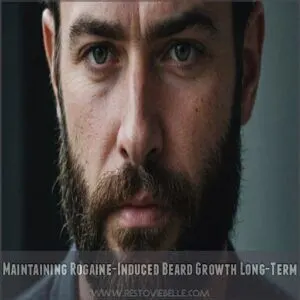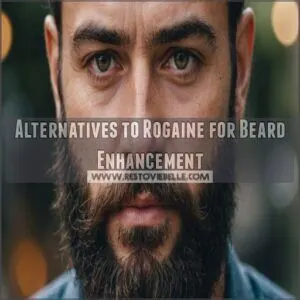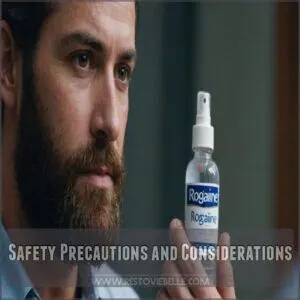This site is supported by our readers. We may earn a commission, at no cost to you, if you purchase through links.
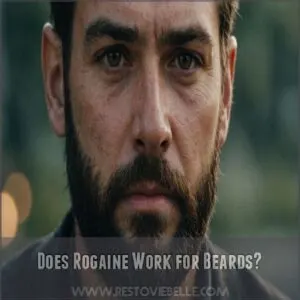 Does Rogaine work for beards? It’s a common question, and the answer isn’t a simple yes or no.
Does Rogaine work for beards? It’s a common question, and the answer isn’t a simple yes or no.
While primarily used for scalp hair, Rogaine (minoxidil) can stimulate beard growth in some men by increasing blood flow to hair follicles.
Think of it as giving your beard a little extra boost. However, scientific evidence supporting its beard-growing prowess is limited.
You might see improved thickness or fill in patchy areas, but results vary wildly.
It’s not a magic bullet, and side effects like skin irritation are possible.
Before you slather it on, chat with your doctor – they can help you weigh the pros and cons.
Want to know more about maximizing your beard’s potential? We’ve got some insider tips you won’t want to miss.
Table Of Contents
- Key Takeaways
- What is Minoxidil?
- Does Rogaine Work for Beards?
- Benefits of Using Rogaine for Beard Growth
- How to Apply Rogaine for Beard Growth
- Potential Side Effects of Rogaine on Facial Skin
- Expected Timeline for Rogaine Beard Results
- Rogaine’s Effectiveness for Different Ethnicities
- Maintaining Rogaine-Induced Beard Growth Long-Term
- Alternatives to Rogaine for Beard Enhancement
- Safety Precautions and Considerations
- Frequently Asked Questions (FAQs)
- Does Rogaine work for beards?
- Can you use Rogaine (minoxidil) for a bushy beard?
- Can Rogaine help a man grow facial hair?
- Does Rogaine 5% minoxidil help thinning facial hair?
- Is Minoxidil 5 or 10 better?
- How can I grow a beard faster?
- Is Minoxidil safe for a beard?
- Can you use Minoxidil once a day for a beard?
- Who can use Minoxidil?
- Will Rogaine grow a beard?
- Are minoxidil beard gains permanent?
- How can I stimulate my beard to grow?
- How long should I leave Rogaine in my beard?
- Can women use Rogaine for facial hair?
- How does diet affect beard growth with Rogaine?
- Are there age restrictions for using Rogaine on beards?
- What happens if you stop using Rogaine on your beard?
- Does Rogaine interact with other beard care products?
- Conclusion
Key Takeaways
- Rogaine (minoxidil) might boost your beard growth by increasing blood flow to hair follicles, but like with hair health benefits that biotin can provide, results aren’t guaranteed and vary widely.
- You shouldn’t expect a miracle; it’s not a magic bullet, and more research is needed to confirm its effectiveness for beard growth.
- Potential side effects of Rogaine for beards, particularly when using it to address conditions like alopecia barbae causes, should be carefully considered. Potential side effects include skin irritation and unwanted hair growth in other areas; you should discuss them with your doctor before using it.
- If you decide to use Rogaine, consistent application is crucial for seeing any potential results, and gains might not be permanent.
What is Minoxidil?
You’ve probably heard of minoxidil as a scalp treatment, but there are other options like chili seed oil that stimulates hair growth by increasing scalp blood circulation and delivering essential nutrients to hair follicles, for instance chili seed oil hair growth. but did you know it affects blood vessels to boost hair growth?
This vasodilation increases nutrient flow to your hair follicles, potentially giving you a fuller beard—even if it doesn’t officially promise to.
How Does Minoxidil Work?
Minoxidil, the active ingredient in Rogaine, works wonders by stimulating hair follicles, but how exactly does it do that?
It influences the hair growth cycle directly, helping dormant follicles jump back into action.
By penetrating the scalp, it promotes healthier hair strands.
Think of it as a jumpstart for your beard’s potential, enhancing its chances to thrive.
Role of Vasodilation in Hair Growth
Picture giving your hair a power boost.
Vasodilation, the widening of blood vessels, is like opening a floodgate for your follicles.
It ramps up blood flow, delivering nutrients and oxygen where they’re needed most.
This process, championed by minoxidil, supports the hair cycle and may enhance hair thickness.
So, it’s no wonder vasodilators are touted for combating hair loss.
Effect on Hair Follicles
You’re in the spotlight when blood vessels expand, increasing blood flow. This boost energizes your hair follicles, playing cheerleader to their growth game. As follicles swell with excitement, they get into:
- Hair Follicle Cycle Awakenings: Each cycle is essential.
- Follicle Stimulation: Keeps things lively.
- Follicle Size Boosts: Larger for healthier hair.
Who knew follicles had so much drama?
Does Rogaine Work for Beards?
Thinking about using Rogaine for your beard might leave you questioning if it really works.
While scientific evidence is limited and results can vary depending on your beard type and genetic factors, some users report modest improvements, much like hoping for an unexpected refund when you least expect it!
Scientific Evidence and Research
So, you’re wondering if the science backs up Rogaine for beard growth?
A 2016 study showed a 3% minoxidil lotion slightly edged out a placebo.
When using minoxidil for beard growth, consider the potential minoxidil and hair oil interactions, as it can affect treatment efficacy.
But, let’s be real, more research is needed.
Clinical trials are ongoing, and current research limitations mean we don’t have all the answers yet.
Peer-reviewed articles are key, and more dosage studies would paint a clearer picture.
Basically, it’s a bit of a waiting game for conclusive proof.
Effectiveness for Different Beard Types
Different beard types can affect how well Rogaine works for you.
Beard density, texture, and genetics play a big role.
Thick, coarse hair might respond differently than fine hair due to varied growth cycles.
Rogaine can promote growth regardless, but results vary.
Embrace your unique beard journey; it’s not just science—it’s about rocking what nature gave you!
Comparison to Scalp Hair Growth
Beard growth and scalp hair regrowth with Rogaine aren’t identical twins. While beard growth can be influenced by various factors, including the use of beard growth products, aren’t identical twins. Their differing hair cycle durations and anagen phases mean distinct results. While scalp treatments shine, the beard’s follicle structure and growth rate variations might tweak outcomes.
- Unexpected thicker strands yet differing texture
- Possible boost during anagen phase
- Follicle changes may surprise you
- Growth feels like a mysterious race
Benefits of Using Rogaine for Beard Growth
Using Rogaine for beard growth might just be the boost you’re looking for, as it can increase blood flow to your hair follicles, potentially leading to a fuller and thicker beard.
While not a guaranteed magic potion, some users notice enhanced hair growth during the anagen phase, making it worth considering if you’re aiming to move from the patchy stage to a mighty mane.
Increased Blood Flow to Hair Follicles
Using Rogaine for beard growth hinges on improving hair follicle health.
Minoxidil widens blood vessels, boosting blood flow and enhancing scalp circulation.
This flow nourishes follicles, providing the fuel needed for the hair growth cycle.
Imagine your beard getting a spa day!
| Benefit | Feeling | Impact |
|---|---|---|
| More Blood Flow | Energized | Stronger Follicles |
| Nourished Follicles | Revitalized | Fuller Growth |
| Healthier Hair | Confident | Thicker Beard |
Enhanced Hair Growth During Anagen Phase
Maximizing your beard’s potential hinges on the anagen phase, the hair growth cycle‘s powerhouse.
By stimulating hair follicles, Rogaine triggers the anagen phase, lengthening its duration for enhanced growth.
In fact, similar to the way Redensyl and Minoxidil stimulate hair growth, Rogaine works to reactivate hair follicles and extend the anagen phase.
Like watering a thirsty plant, this extra boost helps your beard flourish.
Keep it up, and soon you might notice those vellus hairs growing stronger and more defined.
Potential for Fuller and Thicker Beard
Maintaining balanced testosterone levels through healthy lifestyle habits like exercise, nutrition, and stress management techniques plays a significant role in promoting beard growth. Imagine watching your beard grow thicker and fuller — Rogaine might just get you there.
By enhancing blood flow to dormant follicles, it can potentially jumpstart the beard growth timeline.
You’re not just limited to genes and beard myths.
Of course, patience is key, and results can vary.
Whether Rogaine or natural methods, consistent care tips are essential.
How to Apply Rogaine for Beard Growth
Applying Rogaine for a fuller beard is straightforward: use a 3% minoxidil solution, applying a small amount twice daily to your beard area.
Consistency is key—think of it like a dedicated workout for your facial follicles—so keep at it for at least 16 weeks to see if it works for you.
Recommended Concentration and Frequency
The ideal concentration for Minoxidil strength in beard growth is at least 3%.
- Twice daily to see results.
- Consistent use fosters growth during the anagen phase.
- Avoid skipping days; consistency impacts success.
Think of it as giving your beard a twice-daily nudge toward fullness and life.
Application Technique and Duration
Grab an applicator tool and apply Rogaine to your beard area twice daily, once in the morning and evening, keeping in mind that Men’s Rogaine Hair Regrowth has been clinically proven to regrow hair in men.
Use just enough to lightly coat the skin beneath your beard.
Stick to this routine for at least 16 weeks to let the minoxidil do its magic.
Remember, patience is key—let the treatment work over time with consistent application.
Importance of Consistency in Usage
Just like brewing the perfect cup of coffee, long-term success with Rogaine involves patience and daily commitment.
Steady progress begins with twice-daily applications.
Monitor your routine—results take time, but consistency guarantees they come.
Remember, skipping a day is like hitting "pause" on your progress. Keep your eyes on the prize, and your beard will thank you.
Potential Side Effects of Rogaine on Facial Skin
While using Rogaine on your face to boost beard growth, you might notice some unexpected side effects, like redness or irritation on your skin.
Extra hair growth may also pop up in places you aren’t exactly aiming for, adding a hairy twist to your grooming adventure.
Common Skin Irritations and Reactions
When applying Rogaine to your beard, don’t be startled if your skin occasionally throws a tantrum.
You might face some redness, itching, or dryness.
These reactions are like tiny red flags waving for your attention.
Some folks notice bumps or breakouts too.
Keep a watchful eye, and if reactions persist, it’s smart to consult your doctor.
Unwanted Hair Growth in Adjacent Areas
Applying minoxidil to your beard? Watch out for unexpected hair growth in nearby areas. It’s like inviting your mustache to a neighborhood block party—it might spread the cheer elsewhere.
Some ethnicities that can’t grow facial hair may face even more unique beard growth challenges due to genetics.
While you’re focusing on your facial hair, stray hairs could join the celebration on cheeks or neck. Use it sparingly and monitor any guest appearances of rogue body hair.
Systemic Absorption and Safety Concerns
Because Minoxidil is absorbed into your bloodstream, long-term use carries potential health risks.
Rare but serious side effects, like chest pain or dizziness, can occur.
Drug interactions are also possible, so always chat with your doctor before starting.
Minoxidil absorption varies, so monitor yourself closely.
Don’t let potential side effects scare you—just be informed!
Expected Timeline for Rogaine Beard Results
You’ve decided to try Rogaine for a fuller beard, but patience is key as the process unfolds over several stages.
Initially, you might experience some shedding, but this usually leads to the appearance of soft vellus hairs, eventually transforming into the desired thicker terminal hairs.
Initial Shedding Phase
You’ve rubbed Rogaine on your face, ready for that beard magic, but instead, you spot more hair falling out.
This "initial shedding phase" feels like a prank, but it’s not.
Part of the hair loss cycle, this shedding is a sign the product’s working by rebooting your follicles.
Hang tight—this hair-loss teaser is just the opening act in Rogaine’s expected timeline for growth.
Vellus Hair Growth Stage
Once the shedding slows down, keep an eye out for vellus hair popping up.
These fine, light strands are a sign Rogaine’s got the wheels turning.
Check out products for vellus hair beard care here for vellus beard.
Here’s what to know:
- Appearance: Vellus hair looks soft and almost colorless.
- Duration: It lasts a few months, filling gaps.
- Follicles: Vellus hair originates from follicles poised for more growth.
Hang in there; it’s a promising phase!
Terminal Hair Development
Terminal hair development kicks in when those peach fuzz strands mature into robust, dark hairs.
After vellus hair sets the stage, expect thicker growth as follicles extend their anagen phase—the active growth period.
Keep in mind, factors like genetics and consistency in applying Rogaine can influence terminal hair density.
Imagine your beard finally claiming its full, impressive reign!
Rogaine’s Effectiveness for Different Ethnicities
When considering Rogaine for beard growth, you should recognize how different ethnicities can experience varied results due to genetic factors.
While East Asian men might notice less impact because of naturally lower facial hair density, men of color with thicker hair might see more ingrown hairs, adding a unique challenge to their beard journey.
Variations in Results Among East Asian Men
At first glance, expecting lush beard growth might seem out of reach for East Asian men, given genetic and hormonal factors that often lead to lower hair density.
Individual variations in lifestyle habits can mix up these odds.
Like each snowflake is unique, so too are beard growth journeys.
Embrace patience—it might just surprise you with unexpected results!
Efficacy for Men of Color With Thicker Hair
For men of color, thicker, curlier hair can sometimes mean a battle with ingrown hairs, leading to pseudofolliculitis barbae—a condition that mimics folliculitis. This can impact product application and overall results.
Remember, everyone’s beard journey is unique!
- Proper preparation is key to minimizing irritation.
- Consider using a gentle exfoliant to prevent ingrown hairs.
- Individual results vary, so patience is important.
Genetic Factors Affecting Beard Growth
Genetics can be a twisty road map that decides your beard’s destiny.
Ethnic differences play a role; from East Asian men typically having less density to hormonal influences shaping hair texture and density in others.
Rogaine products for different ethnicities, such as those found in Rogaine ethnicity beard products, can help address these variations.
Don’t overlook family history—your grandpa’s beard might just be a hint!
Remember, all these factors dance together to mold your unique beard growth pattern.
Maintaining Rogaine-Induced Beard Growth Long-Term
You’ve successfully kick-started your beard growth with Rogaine, but keeping those gains demands ongoing effort, much like maintaining a garden after the first bloom.
To make sure lasting results, you might need to weigh the benefits of continued use against the thrill of letting your beard move to a lush, natural state.
Continued Use Vs. Discontinuation Effects
Rogaine for beard growth can be a game-changer, but what happens when you stop using it?
Continued use keeps those hair follicles stimulated, maintaining your newfound fuzz.
Discontinuation might lead to hair returning to its previous state, like revoking a green card to your beard’s progress.
Regular application keeps the benefits rolling, while halting use may end the party early.
Transition to Natural Beard Growth
As you start the shift from Rogaine to natural beard growth, patience is your sidekick.
Often, discontinuation sees initial thinning, but don’t fret.
This phase aligns with your beard growth timeline.
Incorporate natural beard care tips to maintain thickness.
Think of it as passing the baton back to your body, ensuring your beard stays robust without the helping hand of Rogaine.
Combining With Other Growth-Promoting Methods
Think of enhancing beard growth like a team effort, where Rogaine meets allies. You can boost results by:
- Beard oil: Keeps hair soft and manageable.
- Minoxidil & diet: A balanced diet supports healthy regrowth.
- Beard supplements: Biotin and vitamins strengthen follicles.
- Laser therapy: Stimulates blood flow and encourages growth.
Complementary methods provide thorough care for your beard journey.
Alternatives to Rogaine for Beard Enhancement
If you’re curious about other ways to boost your beard without Rogaine, many alternatives are worth exploring.
Natural supplements and professional treatments might provide the perfect method to enhance your facial fuzz while avoiding any potential side effects.
Natural Beard Growth Supplements
Want a fuller beard naturally?
Explore supplements like Biotin, known for hair health, or Saw Palmetto, a potential DHT blocker.
Rosemary oil might stimulate follicles.
Remember, though, these aren’t magic bullets.
A balanced diet and managing stress are equally important.
Consult a doctor before trying anything new.
Lifestyle Factors Affecting Beard Growth
A balanced diet rich in essential vitamins and minerals like biotin for hair growth, stress management, and regular exercise can boost your beard game like a secret weapon in your grooming arsenal.
Quality sleep regenerates hair follicles, while ditching smoking protects beard health.
It’s like giving your beard a VIP pass to a healthier, fuller look.
Keep these lifestyle factors in check, and watch your beard flourish naturally!
Professional Treatments and Procedures
Considering natural habits to boost beard growth is wise, but understanding your genetic predisposition and how nutrients like biotin and beard growth vitamins impact your hair growth patterns is key before considering professional treatments, but you might be curious about professional treatments too.
Imagine your beard as a garden in need of planting and nurturing.
Laser therapy zaps follicles to life.
Beard transplants and hair growth injections are available for fuller growth.
Micro-needling and platelet-rich plasma therapy also lend a high-tech hand.
Safety Precautions and Considerations
When you’re thinking about using Rogaine for beard growth, it’s important to think about some safety precautions first.
Certain health conditions and rare, severe side effects make it essential to consult a doctor before diving into treatment—after all, nobody wants an unexpected surprise when aiming for a fuller beard!
Health Conditions That May Interact With Rogaine
As you explore alternatives to enhance your beard, be wary of how your health might play a part.
Before using Rogaine, you can find more information about its safety at Rogaine Safety Products.
Rogaine can flirt with trouble if you have conditions like high blood pressure, heart issues like tachycardia, or organ damage.
Pheochromocytoma is another showstopper.
It’s wise to chat with your doctor first — avoiding unwanted surprises is always smart.
Rare but Severe Side Effects
Before you rush into using Rogaine, be aware of rare but severe side effects.
Minoxidil’s impact might stretch beyond your beard, influencing long-term risks like cardiovascular issues and hormonal changes.
Some people have individual sensitivity, leading to unexpected outcomes.
It’s a bit like playing with fire—exciting, yet potentially hazardous, if you’re not careful.
Importance of Consulting a Doctor Before Use
Talking to your doctor before using Rogaine for beard growth is like having a safety net. They can spot any pre-existing conditions or medication interactions you might overlook.
- Check for potential risks or rare side effects.
- Make sure it’s safe alongside other meds.
- Evaluate how it fits your individual needs.
- Get personalized advice suited for you.
- Address any concerns upfront—no surprises!
Frequently Asked Questions (FAQs)
Does Rogaine work for beards?
Rogaine might help your beard grow but it’s not a sure bet.
While some guys see results, research is limited.
It expands blood vessels, boosting follicle activity.
Remember, consistency and patience are key, but consult a doctor first.
Can you use Rogaine (minoxidil) for a bushy beard?
Yes, you can use Rogaine for a bushy beard, but it’s not FDA-approved for this purpose.
Some users see improved growth, but results vary.
Apply twice daily and expect possible skin irritation or unexpected results.
Can Rogaine help a man grow facial hair?
Ever wondered if thicker facial hair’s in your future?
Using Rogaine for beard growth isn’t officially proven, but it might help.
Some notice more hair, while others find mixed results.
Always consult a doctor before trying.
Does Rogaine 5% minoxidil help thinning facial hair?
Boosting thinning facial hair with 5% minoxidil might work for you, although it’s not officially approved for this use.
Some guys notice improvement over several months, but results vary.
Watch for skin irritation and consult a doctor first.
Is Minoxidil 5 or 10 better?
Choosing between Minoxidil 5% or 10% can depend on your skin’s sensitivity.
The 5% solution is often effective for many users, while the higher concentration may cause more irritation.
Always consult a doctor first.
How can I grow a beard faster?
Want a fuller beard faster? Patience is key; genetics play a big role. A healthy diet and consistent skincare help. Consider minoxidil, but talk to your doctor first.
Is Minoxidil safe for a beard?
Minoxidil can be used safely on beards, but consult a doctor first, especially if you have health conditions.
It’s generally well-tolerated, though side effects like skin irritation may occur.
Everyone’s results vary, so patience is key.
Can you use Minoxidil once a day for a beard?
Trying Minoxidil just once daily for your beard might offer some results, but twice daily is ideal.
Think of it like watering your garden—more frequent care boosts growth.
Always check in with a doctor first.
Who can use Minoxidil?
You can use Minoxidil if you’re generally healthy, but always check with your doctor first, especially if you have heart issues or other conditions.
Its use might tickle the fancy of your follicles, beginning your beard journey!
Will Rogaine grow a beard?
Rogaine might help grow your beard by improving blood flow to hair follicles, but it’s not guaranteed.
It’s primarily meant for scalp use.
If you’re experimenting, proceed with caution, knowing that genetics often play the bigger role.
Are minoxidil beard gains permanent?
Minoxidil’s effects on beard growth aren’t permanent.
Once you stop using it, you might lose some gains over time.
Think of it like watering a plant; without regular use, the growth can dwindle.
How can I stimulate my beard to grow?
Boosting beard growth often involves a mix of patience, a balanced diet, regular exercise, and grooming.
Consider biotin supplements, massage with essential oils, and reducing stress.
Remember, genetics play a key role in your beard’s potential.
How long should I leave Rogaine in my beard?
Apply it twice daily, letting it fully absorb before rinsing. Don’t leave it on longer; more isn’t better. Consistency’s key – think of it like watering a plant, not drowning it!
Can women use Rogaine for facial hair?
While Rogaine isn’t FDA-approved for women seeking facial hair growth, its use on sensitive facial skin might cause irritation.
Consult your doctor before trying it, as women can experience different effects compared to men.
How does diet affect beard growth with Rogaine?
Your diet plays a role in beard growth even with Rogaine.
Eating foods rich in protein, vitamins A, B, C, D, E and minerals like zinc can boost follicle health, potentially enhancing Rogaine’s effects on facial hair.
Are there age restrictions for using Rogaine on beards?
Imagine Rogaine like a magic potion for some, but it’s not age-bound magic.
While typically safe for adults, teens should chat with a doctor first.
It’s all about being smart and understanding your body’s needs.
What happens if you stop using Rogaine on your beard?
Stop using Rogaine on your beard, and you might notice any new hair growth gradually thinning.
It doesn’t mean you’ll lose existing hair, but the enhanced growth due to increased blood flow typically ceases without continued application.
Does Rogaine interact with other beard care products?
Rogaine might just rock your beard world unless it mingles with heavy oils or thick creams, which could mess with absorption.
Stick to lighter, non-greasy products for best results, and avoid harsh chemicals to keep things balanced.
Conclusion
Think of using Rogaine for beards like starting on a hair-growing adventure.
The journey won’t look the same for everyone, with paths that twist and turn based on your unique biology.
While Rogaine, a trusty companion, might boost beard growth in some men, it’s not a One-Size-Solution.
Expect variability in results, and keep an eye on potential side effects.
Consult your doctor to see if this quest aligns with your beard goals.
Does Rogaine work for beards? Sometimes.
